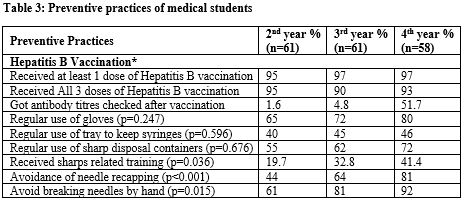Knowledge, Attitude and Practices of Medical Students regarding Needle stick injuries in Villupuram, India – A cross-sectional study
Abstract
Objective: To determine knowledge, attitude and practices of medical students regarding needle stick injuries. Methods: A cross sectional survey was conducted among the consenting medical students of 2nd, 3rd and 4th years at Government Villupuram Medical College and Hospital, Villupuram, India. Convenience sampling was used. Pre-tested questionnaires were administered to approximately 70% of each class. Data was analyzed using SPSS version 26.0. Associations were assessed using chi-square test and Fisher's exact test. A p-value of <0.05 was considered as significant. Results: The response rate of the survey was 85.7%. Sixty-one students (33.9%) were from 2nd and 3rd year each while 58 students (32.2%) were from 4th year. More than 85% students from each class were aware of the possibility of acquisition of Hepatitis B, Hepatitis C and HIV from needle stick injuries. Only 16.4% 2nd year students, 29.5% 3rd year students and 36.2% final year students knew the full details of needle stick injury prevention protocols. Curriculum was cited as an important source of information regarding needle stick injuries. Forty-seven (26.1%) students had received a needle stick injury in the past; however, only 14 students (29.7%) had reported the incident either to their consultant or the Infection Control Office. Conclusion: Overall knowledge of medical students regarding various aspects of needle stick injuries improved with seniority in medical college. However, the domains of attitude and practices need to be improved as the frequency of needle stick injuries was also observed to increase with the increasing year of medical education
Downloads
References
2. Apisarnthanarak A, Babcock HM, Fraser VJ. Compliance with universal precautions among medical students in a tertiary care center in Thailand. Infect Control Hosp Epidemiol 2006; 27: 1409-10.
3. Needle stick injuries. Canadian Centre for Occupational Health and Safety. (Online) 2009 (Cited 2008 Nov 5). Available from URL: http://www.ccohs.ca/oshanswers/diseases/needlestick_injuries.html.
4. Hamid S, Ismail FW, Jafri W. Hepatitis and the healthcare worker - a Pakistani perspective. J Coll Physicians Surg Pak 2007; 17: 240-5.
5. UNAIDS: The Joint United Nations Program on HIV/AIDS. UNAIDS/WHO Epidemiological Fact Sheet. (Online) 2009 (Cited 2008 Nov 10). Available from URL: http://www.unaids.org.
6. EPINet. Exposure Prevention Information Network data reports. University of Virginia: International Health Care Worker Safety Centre 2003.
7. Abbas Z, Jafri W, Shah SHA, Khokhar N, Zuberi SJ. PGS Consensus Statement on management of Hepatitis B Virus Infection 2003. J Pak Med Assoc 2004; 54:150-8.
8. Hamid S, Umar M, Alam A, Siddiqui A, Qureshi H, Butt, J. PSG Consensus Statement on management of Hepatitis C Virus Infection 2003. J Pak Med Assoc 2004; 54: 146-50.
9. UNAIDS Country Profile. (Online) 2009 (Cited 2008 Nov 5). Available from URL: http://www.unaids.org/Unaids/EN/Geographical+area/By+Country/pakistan;July2005.
10. Rai MA, Warraich HJ, Ali SH, Nerurkar VR. HIV/AIDS in Pakistan: the battle begins. Retrovirology 2007; 4:22.
11. Center for Injection Safety. (Online) 2006 (Cited 2008 Nov 6). Available from URL: http://www.safeinjections.org.
12. Anjum Q, Siddiqui H, Ahmed Y, Rizvi SR, Usman Y. Knowledge of students regarding Hepatitis and HIV/AIDS of a private medical university in Karachi. J Pak Med Assoc 2005; 55: 285-8.
13. Okeke EN, Ladep NG, Agaba EI, Malu AO. Hepatitis B vaccination status and needle stick injuries among medical students in a Nigerian University, Niger. J Med 2008; 17: 330-2.
14. Needle stick injuries. Canadian Centre for Occupational Health and Safety. (Online) 2009 (Cited 2008 Nov 10). Available from URL: http://www.ccohs.ca/oshanswers/diseases/needlestick_injuries.html.
15. Deisenhammer S, Radon K, Nowak D, Reichert J. Needlestick injuries during medical training. J Hosp Infect 2006; 63: 263-7.
16. Shen C, Jagger J, Pearson RD. Risk of needle stick and sharp object injuries among medical students. Am J Infect Control 1999; 27: 435-7.
17. Shariati B, Shahidzadeh-Mahani A, Oveysi T, Akhlaghi H. Accidental exposure to blood in medical interns of Tehran University of Medical Sciences. J Occup Health 2007; 49: 317-21.
18. Wicker S, Nürnberger F, Schulze JB, Rabenau HF. Needlestick injuries among German medical students: time to take a different approach? Med Educ 2008; 42: 742-5.
19. Lee JM, Botteman MF, Xanthakos N, Nicklasson L. Needlestick injuries in the United States. Epidemiologic, economic, and quality of life issues. AAOHN J 2005; 53: 117-33.
20. Blegen MA, Vaughn T, Pepper G, Vojir C, Stratton K, Boyd M, et al. Patient and staff safety: voluntary reporting Am J Med Qual 2004; 19 :67-74.
21. Zafar A, Aslam N, Nasir N, Meraj R, Mehraj V. Knowledge, attitudes and practices of health care workers regarding needle stick injuries at a tertiary care hospital in Pakistan. J Pak Med Assoc 2008; 58: 57-60.
22. Rogers B, Goodno L. Evaluation of interventions to prevent needlestick injuries in health care occupations. Am J Prev Med 2000; 18: 90-8.
23. Centers of disease control. Perspective in disease prevention and health promotion update. Universal precautions for prevention of transmission of HIV, HBV and other blood-borne pathogens in the health care settings. MMWR 1988; 37: 377-88.
24. Wilburn SQ Needlestick and sharps injury prevention. Online J Issues Nurs 2004; 9: 5.

Copyright (c) 2023 Author (s). Published by Siddharth Health Research and Social Welfare Society

This work is licensed under a Creative Commons Attribution 4.0 International License.


 OAI - Open Archives Initiative
OAI - Open Archives Initiative


